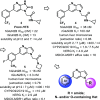1 H-Pyrrolo[3,2- b]pyridine GluN2B-Selective Negative Allosteric Modulators
- PMID: 30891123
- PMCID: PMC6421534
- DOI: 10.1021/acsmedchemlett.8b00542
1 H-Pyrrolo[3,2- b]pyridine GluN2B-Selective Negative Allosteric Modulators
Abstract
Herein, we disclose a series of selective GluN2B negative allosteric modulators containing a 1H-pyrrolo[3,2-b]pyridine core. Lead optimization efforts included increasing brain penetration as well as decreasing cytochrome P450 inhibition and hERG channel binding. The series was also optimized to reduce metabolic turnover in human and rat. Compounds 9, 25, 30, and 34 have good in vitro GluN2B potency and good predicted absorption, but moderate to high projected clearance. They were assessed in vivo to determine their target engagement. All four compounds achieved >75% receptor occupancy after an oral dose of 10 mg/kg in rat. Compound 9 receptor occupancy was measured in a dose-response experiment, and its ED50 was found to be 2.0 mg/kg.
Conflict of interest statement
The authors declare no competing financial interest.
Figures
References
-
- Dravid S. M.; Erreger K.; Yuan H.; Nicholson K.; Le P.; Lyuboslavsky P.; Almonte A.; Murray E.; Mosely C.; Barber J.; French A.; Balster R.; Murray T.; Traynelis S. F. Subunit-specific mechanisms and proton sensitivity of NMDA receptor channel block. J. Physiol. 2007, 581, 107–128. 10.1113/jphysiol.2006.124958. - DOI - PMC - PubMed
LinkOut - more resources
Full Text Sources
Other Literature Sources




